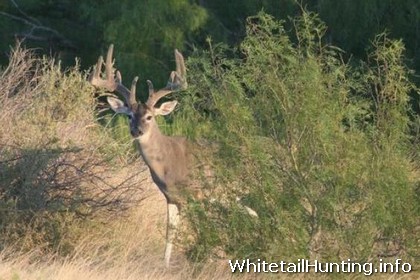The southern portion of Texas can be classified as a place that does not receive a whole lot of rain, but it is also known for outstanding whitetail deer hunting. Much of South Texas is positioned within a semi-arid desert area that expects only 22 to 24 inches of rainfall each year and whitetail living in the area are well adapted. When the rains do fall, they are unpredictable at best. There are portions of South Texas that have only received 1 inch of rain in the last 180 days!
Deer habitat conditions are bad, but could get much worse if summer rains do not fall and offer some relief for hungry, thirsty deer. Living, working and managing whitetail deer through a dry spell is always a concern. Planning ahead to lessen the impacts of drought conditions is important to any ranching or whitetail hunting operation. This is especially important when forecasts indicate a hot, dry summer may be in store for South Texas and the wildlife found there. Here are a few guidelines that may lessen the impact of a below-average rainfall year on your ranch.

First, focus on your deer management goals and techniques, be mindful of costs and allow for flexibility. Maintain a minimum amount of ground cover, and if possible, 1 to 2 feet of herbaceous cover through all seasons is desirable. This residual grass provides fawning habitat and enhances quail production. Leaving herbaceous cover for the next rainfall event provides healthy plants that offer the necessary food and cover for many wildlife species.
The ability to leave standing cover means having a plan to reduce cattle numbers in the pasture and/or move livestock to irrigated crop land or improved pastures. During extended droughts, you may be faced with removing cattle all together. Along with cattle, keeping whitetail deer and feral hog populations within the habitat’s carrying capacity will help reduce the potential for habitat damage.
Additionally, maintain as many working wildlife and livestock water locations as possible, especially during the hottest months of the year. A desirable watering density would be one water location for every 500 acres of deer habitat. This may not be possible on every ranch, but the even distribution of water will spread deer and other wildlife evenly across the landscape. Hot, windy days accelerate the evaporation rates of large stock tanks, but it may more economical to install livestock troughs and wildlife waters.
Another option many ranches use during times of stressed habitat is the implementation of supplemental feed for whitetail deer. This is the last resort to maintain wildlife body conditions and survival in South Texas. The ability to feed wildlife may minimize the impacts on a ranch’s habitat, but long-lasting feed supplementation will impact a landowner’s pocket book and the native habitat as well. The year has been a tough one for white-tailed deer, but they have been here before. Fawn production and antler growth may not be stellar this year, but we are talking about South Texas, so I expect deer hunting will still be really good this season.